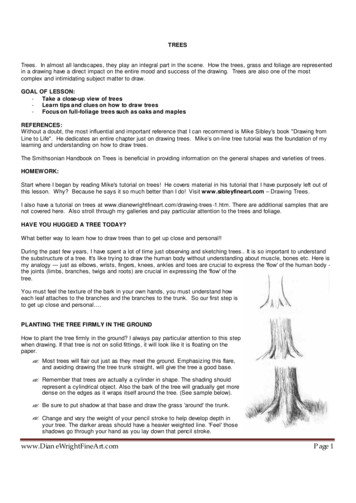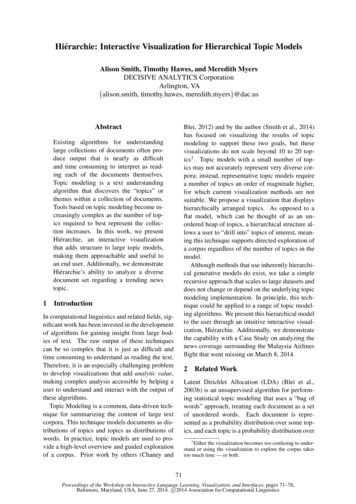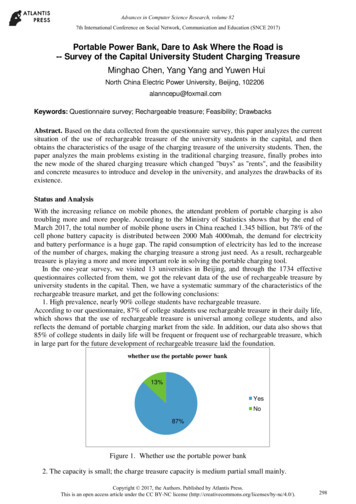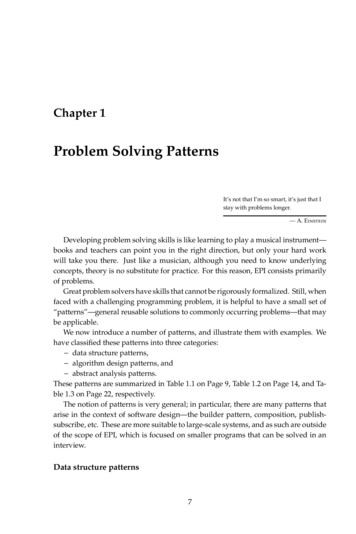
Transcription
Hierarchical Place Trees: A Portable Abstractionfor Task Parallelism and Data MovementYonghong Yan, Jisheng Zhao, Yi Guo, and Vivek SarkarDepartment of Computer Science, Rice duAbstract. Modern computer systems feature multiple homogeneous orheterogeneous computing units with deep memory hierarchies, and expecta high degree of thread-level parallelism from the software. Exploitationof data locality is critical to achieving scalable parallelism, but adds a significant dimension of complexity to performance optimization of parallelprograms. This is especially true for programming models where localityis implicit and opaque to programmers. In this paper, we introduce thehierarchical place tree (HPT) model as a portable abstraction for task parallelism and data movement. The HPT model supports co-allocation ofdata and computation at multiple levels of a memory hierarchy. It can beviewed as a generalization of concepts from the Sequoia and X10 programming models, resulting in capabilities that are not supported by either.Compared to Sequoia, HPT supports three kinds of data movement in amemory hierarchy rather than just explicit data transfer between adjacentlevels, as well as dynamic task scheduling rather than static task assignment. Compared to X10, HPT provides a hierarchical notion of places forboth computation and data mapping. We describe our work-in-progresson implementing the HPT model in the Habanero-Java (HJ) compilerand runtime system. Preliminary results on general-purpose multicoreprocessors and GPU accelerators indicate that the HPT model can be apromising portable abstraction for future multicore processors.1IntroductionModern computer systems feature deep memory hierarchies, multiple heterogeneous or homogeneous computing units, and an emphasis on thread-level parallelism instead of instruction-level parallelism. Exploitation of data locality iscritical to achieving scalable parallelism, but it adds a significant dimension ofcomplexity to performance optimization of parallel programs.In this paper, we introduce a hierarchical place trees (HPT) abstraction thatsupports co-location of data and computation at multiple levels of a memoryhierarchy, as well as three kinds of data movement — implicit access, explicitin-out parameters, and explicit asynchronous transfer — to support differentcommunication mechanisms across memory hierarchies. HPT can be viewed asa generalization of concepts from the Sequoia and X10 programming models, resulting in capabilities that are not supported by either. Compared to Sequoia [5],HPT allows for the three kinds of data movement listed above, rather than just
explicit data transfer between adjacent levels; and for dynamic task schedulingrather than static task assignment. Compared to X10 [7], HPT provides a hierarchical notion of “places” for both computation and data assignment, as well asimplicit data access across places.We use a prototype implementation of HPT model to demonstrate its useas a portable interface for homogeneous (CPU) and heterogeneous (GPU) multicore parallel systems. The evaluation results show performance improvementfor locality-sensitive applications when they run with HPT configurations thatare consistent with the memory hierarchy of the target systems. The magnitudeof the improvement is expected to increase in future many-core systems, wherelocality and data movement will be even more critical for performance than today.The rest of the paper is organized as follows. Section 2 summarizes pastwork on X10’s places and the Sequoia system. Section 3 introduces the Hierarchical Place Trees (HPT) model. Section 4 presents the programming interfacesfor using HPT in the Habanero-Java (HJ) programming language, compiler andruntime. Though this paper discusses HPT in the context of HJ, HPT should beapplicable to other parallel programming models as well. Section 5 presents ourpreliminary experimental results. Finally, Section 6 discusses related work andSection 7 contains our conclusions.2BackgroundThis section summarizes the place and activity features of X10 concurrency anddata distribution models, and the Sequoia’s approach to support portable application development across machines of different memory hierarchies.2.1Places and Activities in X10X10 is an Asynchronous Partitioned Global Address Space (APGAS) languagefeaturing task parallelism and locality control through the use of places [7, 9].A place in X10 (Chapel uses the term, locale, for a similar concept [1]) enablesco-location of asynchronous tasks and shared mutable locations. A computationunit in a place is called an activity (task), which denotes a dynamic executioninstance of a piece of code acting on application data. X10 places are used tosupport both data distributions and computation distributions. Place values canbe obtained in the following ways: (i) here is a constant that denotes the placewhere an activity is executing; (ii) given an object reference V , V.location givesthe reference of the place where the object resides; (iii) a distribution is a mapfrom indices to places that describes how a distributed array is laid out. Given adistribution d, d[pi ] gives the place where the distribution maps the index pi .An X10 program execution contains multiple places; the same X10 programruns, unmodified, regardless of the number of places supplied by the system.Application data may be distributed among places using defined distributionpolicies. In pure X10, all data accesses must be place-local, and a remote dataaccess can only be performed by explicitly creating a new activity at the remoteplace which serves the explicit asynchronous data transfer. In the HPT model
presented in this paper, we permit implicit access to remote locations in additionto explicit data transfers.X10 provides the async and finish constructs for specifying concurrent activity creation and synchronizations. The async statement, async (hplacei) hstmti,causes the parent activity to fork a new child activity that executes hstmti athplacei. Execution of the async statement returns immediately, i.e., the parentactivity can proceed immediately to its following statement. The finish statement, finish hstmti, causes the parent activity to execute hstmti and then waituntil all the activities created within hstmti have terminated (including transitively spawned activities).The statement foreach (point p : R) S supports parallel iteration over all thepoints in region R by launching each iteration as a separate async in the sameplace as the parent activity. A point is an element of an n-dimensional Cartesianspace (n 1) with integer-valued coordinates. A region is a set of points thatspecifies the iteration space for the foreach statement. Likewise, the statementateach (point p : D) S supports parallel iteration over each point p in distributionD by launching an async for point p at place D[p]. Neither the foreach nor ateachstatement has an implicit finish (join) operation. But its termination can beensured by enclosing it within a finish statement at an appropriate outer level.2.2Parallel Memory Hierarchies in SequoiaThe Sequoia programming language and runtime [5] were designed to facilitatethe development of portable applications across machines with different memoryhierarchies. In Sequoia, a memory hierarchy is abstracted using a generic model,the Parallel Memory Hierarchy (PMH) model [2]. A programmer views a memorysystem as a tree, with each node representing a memory module. A Sequoiaprogram is organized in a recursive hierarchy pattern. A program task, whichoperates entirely within its own private address space on a tree node, spawns childtasks onto the child nodes of the tree. Parent tasks may partition data into blocksthat are to be processed by children tasks. Further, the communication betweenparent and children tasks through the memory hierarchy has to be explicitlyexpressed as arguments and results passed between parent and children tasks.The actual computations are performed by tasks on the leaf nodes.In Sequoia, the mapping of a program hierarchy onto a memory hierarchy treeis performed by the compiler according to a mapping specification created by theprogrammer. A specification details how to create and map task instances foreach hierarchy level in the target machine. The compiler unwinds the recursivehierarchy of a Sequoia program based on the mapping specification and createsanother program that contains the static assignment of task instances to thetarget memory hierarchy.The Sequoia runtime requires predefined distributions of both data and tasksat compile time. Such a requirement makes it difficult to write efficient programsfor applications whose data access and computation patterns are not known untilruntime. We have written graph traversal algorithms. Using common data structures, such as adjacency lists, to store a graph, we found that, without implicit
sharing of boundary elements, it is very difficult to partition the graph such thateach subgraph can be processed only by a single task. Another approach is topass the graph to each task and let each task process only a subgraph, but thatapproach requires excessive communication and also poses coordination issueswhen a task needs to notify other tasks that a given vertex was visited already.3Hierarchical Place Trees (HPT) ModelIn the Hierarchical Place Trees (HPT) model, a memory module, such as aDRAM, cache, or device memory, is abstracted as a place, and a memory hierarchy is abstracted as a place tree. Places are annotated with attributes to indicatetheir memory type and size, e.g., memory, cache, scratchpad, register file. A processor core is abstracted as a worker thread. In our current HPT model, workerthreads can only be attached to leaf nodes in the place tree1 . Figure 1 illustratesthe locality-based scheduling constraints in the HPT model. As in X10, we assume that a task can be directed to place PLi by using a statement like “async(PLi )”. However, unlike X10, the destination place may be an internal node or aleaf node in the hierarchy, as illustrated by the task queues associated with eachplace in Figure 1. If a non-leaf place PLi is the target for an async statementin the HPT model, then the created task can be executed on any worker thatbelongs to the subtree rooted at PLi . Thus, an internal node in the HPT servesas a subtree wildcard for the set of workers that can execute a task in its queue.For example, an “async (PL2)” task can be executed by worker w2 or w3. Aconsequence of this constraint is that a worker can only execute tasks from itsancestor places in the HPT. For example, worker w0 in Figure 1 can only executetasks from the queues in places P L3, P L1, and P L0. If a task executing at workerw0 is suspended, we assume that it can be resumed at any worker (including w0)in the subtree of the task’s original target place.1PL31231 PL0 121111111121 3 3 3789 93Fig. 1: Scheduling constraints in the HPT modelFigure 2 illustrates the steps involved in programming and executing an application using the HPT Model. The parallelism and locality in a program is writtenin a way so as to work with any configuration specification. (As discussed in Section 4.3, a configuration consists of an HPT model, and a mapping of the places1In the future, we may relax this restriction and allow worker threads to be attachedto internal nodes, so as to model “processor-in-memory” hardware architecture.
Parallelism andLocality ExpressionMachine independentcompilationCompilationMapping HPT to physicalmemory icationProgramming with HPTRuntime schedulingParallel ExecutionFig. 2: Steps to program and execute an application using the HPT modeland workers in the HPT to memories and processor cores in the target machine.)Thus, the same program can be executed with different configurations, much asthe same OpenMP or MPI program can be executed with different numbers ofprocessors. While it is common to use different configurations as abstractionsof different hardware systems, it is also possible to use different configurationsas alternate abstractions of the same physical machine. The best configurationchoice will depend on the application, and the desired trade-off between localityand load balance for a given task. Auto-tuning techniques can also be used tohelp select the best configuration for a specific application and target system.Place 0Place 0Main MemoryW0PL1L2 CacheW1PL2W2W3(b)L2 ace 0PL1W0A Quad-core workstationPL2W1W2W3(c)Fig. 3: A quad-core CPU machine with a three-level memory hierarchy. Figuresa, b, and c represent three different HPT configurations for this machine.To illustrate how the HPT model can be used to obtain different abstractionsfor the same physical hardware, consider a quad-core processor machine shownin the left side of Figure 3. The hardware consists of four cores (PE0 to PE3)and three levels of memory hierarchy. An HPT model that mirrors this structurecan be found on the right in Figure 3a. However, if a programmer prefers to viewthe shared memory as being flat with uniform access, they can instead work withthe HPT model shown in Figure 3b. Or they can take an intermediate approachby using the HPT model shown in Figure 3c.
It is challenging to develop an interface for data distribution and data transfer that is both portable and can be efficiently implemented across a range ofmemory systems. In SMP machines, data distribution follows implicitly from thecomputation mapping, whereas distributed memory machines and hybrid systems with accelerators require explicit data distributions and data transfers. Tothat end, the HPT model builds on the idea of a Partitioned Global AddressSpace (PGAS), with the extension that the partitioning is not flat and can occuracross a place tree hierarchy. Further, we support three data transfer mechanismsin the HPT model: 1) data distribution with implicit data transfer; 2) explicitcopyin/copyout parameters, and 3) explicit asynchronous data transfer.3.1Implicit Data Transfer with Data Distributions and Array ViewsAll data structures that are to be accessed implicitly using global addresses musthave a well-defined distribution across places. Each scalar object is assumed tohave a single home place. Any access to any part of the object results in a datatransfer from the home place to the worker performing the access. The cost ofthe access will depend on the distance between the home place and the worker.Note that the programmer, compiler, runtime or hardware may choose to createa cached clone of the object closer to the worker, when legal to do so.Distributions of arrays can be more complicated, as evidenced by the wealthof past work on this topic including array distributions in High PerformanceFortran. Unlike a lot of past work on array distributions, the HPT approach toarray distribution builds on the idea of array views [13, 12]. In this approach,a base one-dimensional array can be allocated across a set of places, and thenviewed through a multidimensional index space. Multiple views can be createdfor the same base array, and may range across only a subset of the base array.A key component of an array view is the view’s distribution, which includes thedomain and range of the mapping from the view’s index space to the base array.We use the [.] type notation to denote views and the [ ] type notation todenote arrays. Given an array view A, the restriction operation, A p, defines anew array view restricted to elements of A contained within place p’s subtree.Note that applying a restriction operator does not result in any data copying ordata redistribution. Data transfer only occurs when an array view is dereferencedto access an element of the underlying array.3.2Explicit Synchronous Data Transfer using IN, OUT, andINOUT ParametersA simple alternative to implicit data access is to support data transfer via explicit IN, OUT, and INOUT parameters, analogous to a dataflow model. In HPT,this is accomplished by extending the async construct with IN, OUT, and INOUT clauses. Upon launching a task at its destination place, the data specifiedby IN and INOUT clauses will be copied into the temporary space of the destination place. When the task completes, the data specified by the OUT andINOUT modifiers will be copied back to their original location. This parameterpassing approach is especially well suited to master-worker execution models ondistributed-memory and hybrid systems.
3.3Explicit Asynchronous Data TransferWith IN, OUT and INOUT parameter semantics, the calling task blocks on thecallee task until it has completed execution and all data transfers associatedwith the OUT clauses have completed. However, in many cases it is desirable toperform the data transfer asynchronously so that it can be overlapped with computation in the caller and callee tasks. To that end, we introduce an asyncMemcpy(dest,src) primitive in HPT, that can be used to initiate asynchronous datatransfers between places. An asyncMemcpy call delegates the data transfer toa background worker (which could be a hardware resource such as a DMA engine) and returns with a handle of type futurehvoidi that can be used to checkthe transfer status. As with async operations, there are two ways to check fortermination. First, a force() operation can be performed to block on a specificasyncMemcpy() operation. Second, a finish statement can be used to ensure thatall asyncMemcpy() operations launched in the scope of the finish have completedwhen execution progresses past the finish statement.4Programming Interface and ImplementationWe have implemented a prototype of the HPT model as extensions of the HabaneroJava (HJ) language and runtime system [12]. HJ is a Java-based task parallel language derived from X10 v1.5 [7]. As discussed earlier, Figure 2 shows an overviewof the steps involved in programming and executing an application using the HPTmodel. Programmers write their application using the HJ language and the HPTinterfaces. Then the program is compiled using the HJ compiler and linked withthe HPT and HJ runtime library. To launch the application, the runtime systemrequires an execution configuration (described in Section 4.3) in order to map theapplication computation and data access onto the hardware. During execution,the runtime system is responsible for task scheduling and data movement.4.1HPT Interfaces and Language ExtensionsIn this section, we briefly summarize the HPT interfaces and language extensionssupported by our prototype implementation. Table 1 lists some of the place-basedAPIs available to programmers for the HPT model. We also added three clauses(IN, OUT, INOUT) to the async and ateach constructs in support of the explicitdata transfer discussed earlier:INOUT Expr : [IN(Expr,.)][OUT(Expr,.)][INOUT(Expr,.)]ASYNC Expr : [acc] async [place expr] [INOUT Expr] {statements}ATEACH Expr : [acc] ateach [placeSet expr] [INOUT Expr] {statements}The acc modifier is inspired by a similar keyword used for single-source programming of accelerators in [16] and related approaches. However, it has a moregeneral meaning in the HPT model. We require that an async or ateach statement executed with the acc modifier does not perform any implicit data accessoutside its place; any attempt to perform such a data access will result in an
exception akin to X10’s BadPlaceException [7]. While this is a requirement forexecution on an accelerator like a GPGPU, the acc modifier can be applied toany task running on a CPU as well. All communication with an acc task must beperformed explicitly using IN, OUT, INOUT clauses and/or asyncMemcpy calls.NamedistgetCartesianView(int rank)DescriptionReturn a rank-dimensional Cartesian view of thisplace’s child places (per-dimension factoring of childrenis selected by the runtime)distReturn a Cartesian view of this place’s child places usgetCartesianView(int[ ] dims) ing the per-dimension factors given in the dims arrayboolean isLeafPlace ()Return true if this place is a leaf placeSet place getChildren()Return all the child places of this placeplaceType getType()Return the place’s storage type (memory, cache, etc)int getSize ( )Return the memory size available at this placeTable 1: Subset of place-based API’s in the HPT model4.2Programming Using the HPT Interface for Implicit Data AccessIn Figure 4, we show a recursive matrix multiplication program (C A B) written in HJ using the HPT interface. There are two portions of code in the example:the code for leaf places executed when the isLeafPlace( ) predicate evaluates totrue, and the code executed for non-leaf places otherwise.1234567void MatrixMult(double[.] A, double[.] B, double[.] C) {if ( here.isLeafPlace( ) ) { /* compute the sub-block sequentially */for (point [i,j,k] : [A.region.rank(0), B.region.rank(1), A.region.rank(1)])C[i,j] A[i,k] * B[k,j];} else {/* retrieve children places and structure them into a 2-D Cartesian topology, pTop */dist pTop here.getCartesianView( 2 );8/* generate arrayfinal double[.] C/* generate arrayfinal double[.] A/* generate arrayfinal double[.] B91011121314view that block-distributes C over the 2-D topology, pTop*/d dist.block( C, pTop );view that block-distributes A over pTop’s 1st dimension (rows) */d dist.block( A, pTop, 0 );view that block-distributes B over pTop’s 2nd dimension (columns) */d dist.block( B, pTop, 1 );15/* recursive call with sub-matrices of A, B, C projected on to place p */finish ateach( point p : pTop ) MatrixMult( A d p, B d p, C d p );1617}1819}Fig. 4: Matrix multiplication exampleFor simplicity, this example only uses implicit data accesses through arrayviews. The views, A d, B d and C d, are used to establish the subregions forrecursive calls to MatrixMult() via restriction operators of the form A d p. Notethat creating views does not result in a redistribution of the arrays. Instead, theuse of the ateach construct in line 17 has the effect of establishing an affinity (akinto tiling) among iterations through the recursive structure of MatrixMult().
4.3Execution ConfigurationsAs shown in Figure 2, an HJ program written using the HPT interface can beexecuted on different systems, and with different execution configurations. Theconfiguration specification is supplied as an XML file, and describes the targetmachine architecture as a physical place tree (PPT) as well as a mapping ofthe HPT to the PPT. Figure 5 shows the PPT specification for the quad-coreworkstation shown in Figure 3. In our approach, the mapping is performed whenlaunching the program. This is different from the Sequoia approach in whichthe mapping is performed by the compiler, thereby requiring a recompilation togenerate code for each new hardware configuration. ppt:Place id "0" type "memory" xmlns:ppt "http://habanero.rice.edu/pptl" . ppt:Place id "1" type "cache" size "6291456" unitSize "128" !-- L2 cache -- ppt:Place id "3" type "cache" cpuid "0" ppt:Worker id "0" cpuid "0"/ /ppt:Place ppt:Place id "4" type "cache" cpuid "1" ppt:Worker id "1" cpuid "1"/ /ppt:Place /ppt:Place ppt:Place id "2" type "cache" size "6291456" unitSize "128" !-- L2 cache -- ppt:Place id "5" type "cache" cpuid "2" ppt:Worker id "2" cpuid "2"/ /ppt:Place ppt:Place id "6" type "cache" cpuid "3" ppt:Worker id "3" cpuid "3"/ /ppt:Place /ppt:Place /ppt:Place 123456789101112Fig. 5: Physical place tree specification for a quad-core workstationIn Figure 5, the type attribute is used to specify the type (memory, cache,or accelerator) of the memory module the place represents. The size attributespecifies the place’s storage size (cache or memory). The cpuid attribute is onlyvalid for a worker and is used as a target for mapping HPT worker threads.4.4Unified CPU/GPU CodeAs mentioned earlier, the acc modifier for async and ateach asserts that no implicit data access will be performed outside the task’s local place. Such activitiesare suitable for execution on hardware accelerators, such as GPUs, if available,but can also run on CPUs if so desired. However, the converse is not true i.e.,a task without an acc modifier cannot be executed on a GPU. For GPU executions, our prototype implementation leverages the JCUDA compiler and runtimelibrary [11] for generating Java glue code and JNI stub functions that handledata transfer between CPU memory space and GPU memory space. The currentHPT implementation restricts the use of acc keyword to occur with nested ateachand foreach statements that facilitate code generation for a GPU.Figure 6 shows the usage of the acc keyword with the INOUT clause in theCPU/GPU unified code for the Java Grande Forum Series benchmark. Figure 7 shows the compiler transformed pseudo-code after the first stage of analysis, mainly converting the nested ateach and foreach to an if-else branch. Thetop.isCUDAGrid( ) condition of the branch evaluates to true if the current topology is a CUDA grid configuration, thereby splitting the code into two paths: theGPU path and the CPU path.
double[] baseArray new double[ [0:1, 0: array rows-1] ];double[.] testArray dist.blockView(baseArray);123void doSeries( ) {dist top here.getCartesianView(1);finish acc ateach( place p : top ) INOUT (testArray) {foreach( point i : testArray p ) seriesKernel( testArray, i ); }}45678Fig. 6: Unified CPU/GPU code for Series example using INOUTvoid doSeries( ) {dist top here.getCartesianView(1);123if ( top.isCUDAGrid( ) ) {int [ ] dimBlocks { 256, 1, 1 }; // 256 is the desired block sizeint [ ] dimGrids { ( array rows dimBlocks[0] - 1 ) / dimBlocks[0], 1, 1 };/* The definition of seriesKernel (not shown) specifies an INOUT attribute for testArray */seriesKernel stub.seriesKernel dimGrids, dimBlocks ( testArray, array rows );} else {final dist d dist.block( testArray, top );finish ateach( place p : top ) {foreach( point i : [d p.rank(0).low( ) : d p.rank(0).high( )] )seriesKernel( testArray, i ); }}4567891011121314}15Fig. 7: Compiler-generated pseudo-code for Series benchmark from Figure 6 usingJCUDA for the GPU path5Preliminary Experimental ResultsIn this section, we evaluate a prototype implementation of the HPT model in theHJ system with the JCUDA extension for GPU’s [11]. The experimental resultswere obtained on three system architectures: a Niagara T2, a Xeon SMP, anda hybrid system with NVIDIA Tesla C1060 GPGPUs. The Niagara T2 has a8-core UltraSPARC T2 processor clocked at 1.2GHz, and 32GB main memory.Each core supports 8 hardware threads, and all cores share a single 4MB L2 cachewith 8 banks. The Xeon SMP has four Quad-Core Intel Xeon E7330 processorsrunning at 2.40GHz with 32GB main memory. Each quad-core processor has twocore-pairs and each core-pair shares a 3MB L2 cache. A single NVIDIA TeslaC1060 GPGPU has 4GB memory and 240 cores in 30 streaming multiprocessors(SM’s), running at 1.3 GHz clock speed. Each SM has 8 scalar cores and 1 doubleprecision FPU, and 16KB shared (local) memory.The benchmarks used for evaluation include the 2D Successive Over-Relaxation(SOR) and IDEA encryption (Crypt) benchmarks from the Java Grande ForumBenchmark suite [6], and Conjugate Gradient method (CG) from NAS Parallel Benchmarks [3]. Both CG and SOR2D are locality-sensitive applications astheir computation kernels include matrix and vector operations that exhibit bothspatial and temporal reuse. For GPU evaluation, we also include a Matrix Multiplication (MatrixMult) kernel that computes the product of two 1680 1680 densesingle-precision matrices. The Crypt benchmark is an example of a streaming ap-
plication, and was chosen as a counter-point to SOR, CG, and MatrixMult. Weadded one more size, D (100M), to study the impact on large data size streaming. For evaluating HPT on cache memory hierarchy, we use data distributionfor data sharing; and for evaluation on GPUs, we use IN, OUT and INOUT tospecify data transfer between places.The JVM used for evaluation is Sun JDK 1.6, invoked with the following options: -Xmx2g -Xms2g -server -Xss8M -XX: UseParallelGC -XX: AggressiveOpts.For all results shown below, we report the average performance across 20 executions so as to reduce the impact of JIT compilation and garbage collection.5.1Evaluation on CPU Memory and Cache ArchitectureTo evaluate the HPT model for CPU memory and cache architecture, we createdthree execution configurations for each of the Niagara T2 and Xeon SMP. Theconfiguration details are listed in Table 2.Machine Config1x64Niagara T28x8DescriptionOne root place with 64leaf places8 non-leaf places, each ofwhich has 8 leaf places64x1 64 non-leaf places, eachof which has 1 leaf place1x16 One root place with 16leaf placesXeon SMP8x2 8 non-leaf places, each ofwhich has 2 leaf places16x1 16 non-leaf places, eachof which has 1 leaf placeModelingEach leaf place represents the L1 cache ofa T2 SMT threadThe 8 non-leaf places represent 8 L2 cachebanks; the 8 leaf places of each non-leafplace represent the 8 SMT threadThe 64 non-leaf places represent the L1cache of the total 64 SMT threadsEach leaf place represents the L1 cache ofeach of the 16 coresThe 8 non-leaf places represent the 8 L2caches of the 8 core pairs; the 2 leaf placesof each non-leaf place represent the 2 L1caches in each core pairThe 16 non-leaf places represent the L1caches of the total 16 coresTable 2: Execution configurations for Niagara T2 and Xeon SMPThe 8x2 configuration for the Xeon SMP and the 8x8 configuration for theNiagara T2 most closely model sharing at the L2 cache level for these two machines. Table 3 includes the execution times in seconds for three benchmarkswith different problem sizes using three configurations on the two machines. Onthe Xeon SMP, the 8x2 configu
a high degree of thread-level parallelism from the software. Exploitation of data locality is critical to achieving scalable parallelism, but adds a sig-nificant dimension of complexity to performance optimization of parallel programs. This is especially true for programming models where locality is implicit and opaque to programmers.











